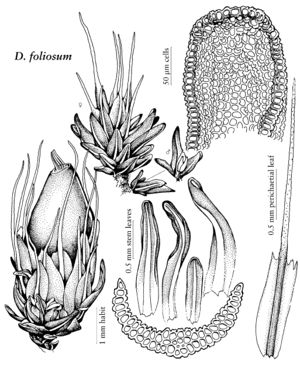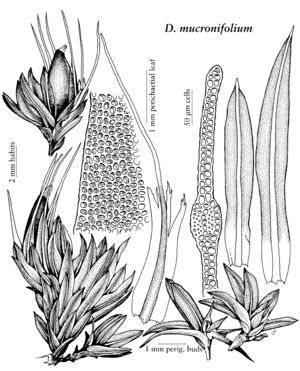Plants perennial, medium-sized, 0.5–1 cm, forming dense turf, rhizoids often firmly compacting the mineral substratum, dark to dull green; protonema producing funnel-like flaps (rarely discernible in most specimens). Stems short, erect, usually simple, 0.5–2 mm. Leaves proximally reduced, crowded, often crisped when dry, sometimes radially inrolled, spreading when moist, lingulate or lingulate-subulate, rounded-obtuse to acute, mainly entire; costa single, strong, lamina usually 2 (–3) -stratose from costa to near margins, cells roundedquadrate to rounded-hexagonal, thick-walled, plane, mammillose or papillose on one or both surfaces; cells at or near base 1-stratose, hyaline, smooth, rectangular or oblong-hexagonal. Sexual condition autoicous or dioicous; perigonial shoots with few, short-lingulate leaves enclosing paraphyses and few antheridia; paraphyses filamentous; interior perichaetial leaves usually longer than exterior leaves, erect, often scarious, ovatelanceolate, lance-subulate to linear, generally lacerate or ciliate at apex, awned by long-excurrent costa, brown and mainly without chlorophyll when mature. Seta very short, smooth, central strand absent. Capsule obliquely oriented, nearly completely enveloped by perichaetial leaves, asymmetric, ovoid, at the base often strongly bulging on upper side, narrowed to a conic operculum and narrow mouth, annulus present, neck absent, stomata phaneropore in 2 rows near base or absent; peristome double or sometimes absent, with a white densely papillose endostome of 16 pleats, somewhat twisted when dry and toothed at apex of each of the keels, exostomial teeth rudimentary, fewer in number than the pleats. Calyptra smooth, covering operculum.
Distribution
North America, Mexico, West Indies, Central America, South America, Europe, Asia, Atlantic Islands, Pacific Islands, Australia
Discussion
Genera 3, species 15 (1 genus, 2 species in the flora).
Diphysciaceae’s three genera are Diphyscium with ca. 12 species, Theriotia Cardot with two species in Southeast Asia, and Muscoflorschuetzia Crosby with one species in Chile. The three were recently merged (Z. L. K. Magombo 2003) into a single genus, Diphyscium, with 15 species.

